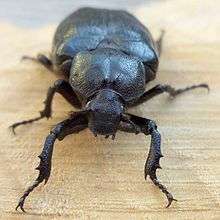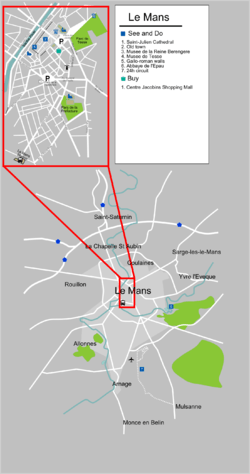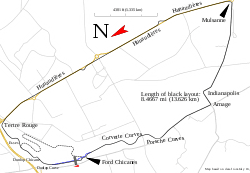Le Mans
Le Mans is a town in Pays de la Loire in France, best known for its annual 24-hour automobile race. Le Mans is twinned with Bolton, England.

Understand
The rich 17-century history of Le Mans, former capital of the province of Maine, is too often eclipsed by the world famous annual 24-hour race, held on the edge of the city.
There are, however, beautiful reminders of the past and a gloriously restored old city, which was used as a backdrop for several movies. Saint-Julien Cathedral, at its heart, is a wonder and should not be missed.
The city is very easily accessible from Paris, it has much to offer and deserves more than only a short trip to its circuit when the motors roar. The "Cité Plantagenêt" may be one of the best-kept secrets in France.

Those more concerned for the environment will be encouraged that the building of the A28 motorway to the south of the city (between Écommoy and Tours) was delayed for several years after a rare protected beetle (the Pique Prune) was found living in the intended route. Motorway development had to be delayed whilst the beetle was relocated.
The famous 24 Hours Le Mans race is run partly on race circuit, partly on (closed-off) public roads. In 1999 Pete Dumbreck suffered a serious dramatic accident when his Mercedes did a backwards somersault rotating 3 times in the air at 190 mph reaching a height of nearly 50 ft and landing clear of the track (road). He was knocked unconscious but then woke-up and got out of the car before being found by race marshals and Gendarmes. In accordance with French Law, he was then breathalysed because the accident took place on public roads. He was then transported to hospital for checks before being released.
Take your time to get up to date information at the 🌍 Office du Tourisme in Square des Ursulines, which is a 10 minute walk from the Cathedral ("Comtes du Maine - Office du tourisme" station on line T2).
Get in
By plane
There is a very small airfield located near the circuit, with no regular connections to other major cities. As there is a direct TGV access from Paris Charles de Gaulle Airport, there is absolutely no point in trying to get to Le Mans by plane, unless you have a private or chartered (small) plane. Ryanair operate flights from London and Porto to Aeroport Tours Val de Loire, just outside the city of Tours approximately 100 km from Le Mans.
By train
The hourly TGV from Paris Montparnasse stops in Le Mans (ZLN IATA), and the 210-km trip takes 55 minutes. There is also a direct TGV service from Charles de Gaulle Airport (bypassing Paris en route to Nantes or Bordeaux). This journey takes 90 minutes, and the train ticket to Le Mans can be combined with your incoming flight, as if it were a connecting domestic flight.
Le Mans is also easily accessible from Brittany, Bordeaux and Nantes. Some TGVs run to and from Lille for Eurostar connections to and from London. Regional trains give you access from the nearby cities of Angers, Caen, Tours and Laval.
By car
The A11 L'Oceane highway runs from Paris to Nantes via Le Mans, and the A81 from Le Mans heads west to Rennes. It takes roughly 2h from Paris to drive to Le Mans. The city of Chartres, halfway from Paris has a magnificent cathedral which deserves a stop. The more recently constructed A28 north-south motorway runs past the city from Rouen and Alençon in the north to Tours in the south.
Get around
Public transport
Public buses are available, and a tramway is in operation.
Line T1 runs from the university in the west of town, through the centre and then out east and south, to the "Antares" terminus which is at the Le Mans 24 hour circuit. Line T2 goes from "Bellevue - Hauts de Coulaines" in the north-east to the city centre, where it joins T1; from here, T2 goes to its terminus at "Les Sablons", close to the Abbaye de l'Épeau.
Getting around
For tourists, major "getting around" is between the railway station and the city centre, which involves either a 30 minute walk, a short taxi ride or a 5 minute tram ride (lines T1 and T2)
Getting to the circuit is a bit longer (20 minutes by taxi, or 30 minutes by tram, line T1). Walking to the circuit from town is not really convenient except when there are too many cars and traffic jams.
The modern city centre is the Place de la Republique (T1), whereas the old heart of the city is behind the Place des Jacobins (T2). Various shops (including the Jacobins shopping centre), bars and restaurants dot the 20 minute walk between the two areas.
See

- The splendid 🌍 Saint-Julien Cathedral, located in the heart of the town, is a magnificent example of the lengths and efforts people expended to build up such buildings in the Middle Ages. With its reversed rounded arches, it is one of the most impressive religious monuments in the area, and one of the largest cathedrals in France. Its building started in the 11th century and took over 500 years. Techniques and styles evolved throughout its history. As a result, the cathedral is a mix between various architectural styles. The nave is pure Romanesque, but the choir is in flamboyant Gothic. The stained glass inside the cathedral should not be missed. One of the panes, dating back from the twelfth century, is the oldest stained glass still standing in the world. One of the chapels presents a painted celling, with angels playing various instruments.
- The Old City (Cité Plantagenêt), just behind the cathedral, is a large and nice example, with many houses and buildings dating back from the late Middle Ages and early Renaissance (look for the Pilier Rouge or the Maison des Deux Amis). The paved streets and limited traffic make for a nice strolling in this very "middle age looking" old town. In the old town, you can stop at the little 🌍 Musée de la Reine Bérengère for some displays about the local history. The large 🌍 Palais des Comtes du Maine palace is now part of the city hall and can not be visited. Ruins of a 🌍 Roman thermal building, dating from the 3rd century, have recently been uncovered. They can be visited with a prior reservation (02 43 28 17 22).
- The 🌍 Gallo-Roman Walls, around the old city, date back from the third century and are still in excellent condition.
- The 🌍 Carré Plantagenet is the local museum of history. The historical collection covers prehistory to the end of the middle-ages, with an important focus on the Gallo-Roman period.
- The 🌍 Musée de Tessé, just outside of the old city, offers displays of various interest, with a reconstitution of an Egyptian tomb at the basement.
- 🌍 L'abbaye de l'Épau (Epau Abbey), on the Eastern side of the town, was founded by Queen Berengaria of Navarre, widow of Richard I of England (Richard Lionheart). Only ruins were remaining during the 1950s, but after 30 years of restoration, the Abbey, now a property of the prefecture, can be visited and is used for cultural events, notably the Festival de l'Epau.

- The 🌍 Circuit of the 24 Heures du Mans is located at the south end of the city. The famous Hunaudieres straight is actually part of the public road from Le Mans to Tours. You can visit some of the rest circuit, though it is of limited interest if there is no race. Seeing the 24 h, is of course a very different story. The town buzzes with many international visitors and the noise of the motors can be heard from the city center. Try to stay awake for the whole 24 h, as the glow of the carbon brakes in the night with racing faster than Formula One is unforgettable. The tradition at the end of the race is for the public to invade the circuit. Although it is officially prohibited, a few thousand people each year take the chance of a lifetime to take a stroll on the bitumen. Close to the circuit is a large Automobile Museum, open even if there is no race.
Do
- 🌍 Gliding Club/Flights/School (Les Ailes du Maine Planeurs), Aérodrome, Route du Chêne (D323), 72100 Le Mans, ☎ +33 2 43 78 24 87, e-mail: lemansplaneurs@gmail.com. Trial flight €100. 2 long flights €190. 5 flights €300. Other options available.
- 🌍 Automobile Club de l’Ouest (ACO). Apart from famous the Le Mans 24 h race each year there are many other races organised by the Automobile Club de l’Ouest (ACO) including 24 h lorry race, a 24 h motorbike race and a 24 h karting race as well as frequent club races. It is an active motor racing club that has its own race circuit which forms part of the extended 24 h race circuit.
- 🌍 Golf de Sargé, rue du Golf, 72190 Sargé Lès-Le Mans, ☎ +44 2 43 76 25 07, e-mail: golfdesarge@gmail.com.
- 🌍 Piscine Municipale d'Allones ((Public Swimming Pool)), av du 19 mars 1962, 72700 Allonnes, ☎ +33 2 43 80 75 10, e-mail: piscine@ville-allonnes.fr. Opening times vary for school term time, school holidays and bank holidays.
- 🌍 Les Atlantides (Public Swimming Pool), 4 av de Volos, 72000 Le Mans, ☎ +33 2 43 50 05 21. Complex opening times at different times of year with different schedules for different activities (e.g. aqua-gym, etc.) in different pools.
Eat
Rillettes, a kind of boiled pork pate, is the culinary specialty of Le Mans. It actually tastes much better than its description. You can buy some rillettes in almost every meat shop in town, and it makes for the perfect sandwich pasted on some fresh baguette.
A very good variety of restaurants is found in the town center and especially in or around the old city. For 50 Euros and a very good sample of French cuisine, give a try to Le Grenier à Sel, 26 Place de l'Éperon, La Ciboulette, 14 Rue de la vielle porte, or Le Nez Rouge, 107 Grande rue, all of them close or inside the old city. Le Baobab, on the same street as La Ciboulette, offers some African cuisine at the very heart of the old city.
The area closer to Place de la Republique, popular with young people on weekends, offers cheaper eats, with several kebab shops that would fill you for 10 euros or less.
- 🌍 Papa Chapter, boulevard Pierre Piffaut, ZI Sud Vitaxis, 72100 Le Mans, ☎ +33 2 43 16 18 20. M-F 11:30-14:30 (longer during Le Mans 24 Hours!).
- 🌍 Auberge de 7 Plats, 79, Grande Rue, 72000 Le Mans, ☎ +33 2 43 24 57 77. Closed Su & M.
- 🌍 Caffé Rossi, 7 pl Des Jacobins, 72000 Le Mans, ☎ +33 2 43 28 04 06, e-mail: contact@cafferossi.comm.
- 🌍 La Fontaine des Saveurs, 43 rue d'Arcole, 72000 Le Mans (opposite Palais des Congrès et de la culture), ☎ +33 2 43 24 55 91, e-mail: restaurant@fontaine-des-saveurs.fr.
Drink
Le Mans is a rather quiet town (except for a few hours once a year) and the university campus is quite far from the centre, so on weekdays the streets are almost empty and the bars are calm, to say the least.
The majority of bars and pubs are located close to 🌍 Place de la Republique. The main arteries for an evening drink in Le Mans would be Rue du Port, going from Place de la Republique to Sarthe river, and Rue du Docteur Leroy, also starting from Place de la Republique.
On weekends, there are a few busy spots, you can check the Le Passeport du cochon vert, 25 Place d'Alger (its name would poetically translate as The Green Pig Passport), both are frequented by a young clientele.
In the old town, Le Saint-Pierre, 7 Place Saint-Pierre (facing the town hall), is completely packed during the week-ends. Going down from the old town towards the place de l'éperon, Le Chicago 5 rue de la vieille porte, is the place to be for cocktail amateurs, with a rum/Cuban-themed ground floor and a lounge/prohibition theme on the first floor.
One of the heritage houses of the old city, Le Pilier Rouge, 5 rue du Pilier Rouge, has been fully restored into a bar. It is located right above the huge tunnel crossing under the old city.
- 🌍 Le Mulligans (Irish pub), 44 Rue du Dr Leroy, 72100 Le Mans, ☎ +33 2 43 14 26 65.
- 🌍 Le Chicago, 5 rue de la Vielle Porte, 7200 Le Mans, ☎ +33 2 43 29 25 67, e-mail: contact@lechicagobar.com. Tu-Sa 17:00-02:00.
- 🌍 Le Lézard, 8 rue de la Barillerie, 72000 Le Mans. M-Sa 12:00-02:00.
- 🌍 Washington D.C., 2 rue de la Mission, 72000 Le Mans, ☎ +33 2 43 84 63 53.
- 🌍 Le Verre Tige, 48 grande rue, 72000 Le Mans, ☎ +33 2 43 28 39 00.
There are a few gay bars, notably La Limite, 7, Rue Saint-Honore in the old city, or L'Arc en ciel, 2 Rue Doree, also in the old city.
Sleep
The area around, and even inside, the loop of the circuit is full of campgrounds (the Houx and the Maison Blanche), which are very busy during the race. We are talking here about campgrounds located very close to a deafening source of noise, invaded by hordes of motor and beer fans, so the last thing you should expect to be doing there is sleeping. But if you are in Le Mans for the 24 h, you do not want to be sleeping (and prices skyrocket). For more information about camping around the circuit, take a look at the aptly named Le Mans Camping Survival Guide.
- 🌍 Camping Le Vieux Moulin, Le Vieux Moulin, 72190 Neuville-sur-Sarthe (10 km N of city.), ☎ +33 2 43 52 41 40, e-mail: reception@campinglevieuxmoulinlemans.com. Web site is very slow responding. Pitches, chalets or luxury tents.
You can find some business hotels directly at the train station (south exit), or just across the street at the north exit. There are some average to luxury hotels in the centre (for instance Hotel Concorde, located on Avenue du General Leclerc, not very far from the station, or Mercure on Rue Chanzy). If you come for the race, book well ahead, but at other times, it should not be a problem to get a room.
There is actually one hotel located directly on the circuit, the hotel Arbor, located at km 6 on the Hunaudieres straight, just before Mulsanne. Book years ahead.
- 🌍 Hôtel Campanile Le Mans Sud, boulevard Pierre Le Faucheux La Gémerie, 72230 Arnage (by Lac de la Gémerie, 9 kn S of city), e-mail: lemans.arnage@campanile.fr. 3*, Free Wi-Fi.
- 🌍 Mercure Le Mans Centre Hotel, 19 rue Chanzy, 72000 Le Mans, ☎ +33 2 43 40 22 40, e-mail: H5641@accor.com. Check-in: from 14:00, check-out: by 12:00. Wi-Fi, parking, air-conditioning, 24 hr reception, pets allowed (charged)
- 🌍 ibis Le Mans Centre Hotel, Quai Ledru Rollin, 72000 Le Mans, ☎ +33 2 43 23 18 23, e-mail: H0780@accor.com. Check-in: from12:00, check-out: by 12:00. Parking, pets allowed (charged), Wi-Fi, no-smoking hotel.
- 🌍 Le Doyenné - La Maison d'Elise (Chambres d'hôtes), 8 rue du Doyenné, 72000 Le Mans, ☎ +33 2 43 47 85 11, e-mail: lamaisondelise-doyenne@orange.fr. 85 € - 165 € (breakfast included).